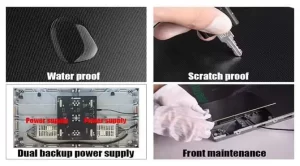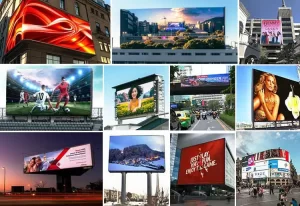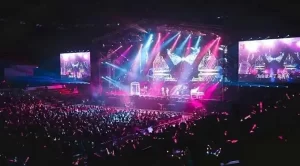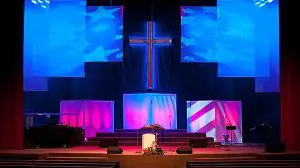Introduction
The global display industry is undergoing a paradigm shift with the emergence of flexible LED displays, a technology redefining the boundaries of visual communication. Combining breakthroughs in material science with novel manufacturing processes, these bendable LED screens are unlocking unprecedented applications across industries. By 2026, COB-based flexible displays are projected to capture 22% of the creative display market (Futuresource), driven by their durability, energy efficiency, and design versatility. This article explores the technical foundations, commercial implementations, and economic advantages of this transformative technology.
Material Innovations: Engineering the Future of Flexible Displays
1. Advanced Substrate Materials
Traditional rigid displays rely on FR4 PCB substrates with high thermal expansion coefficients (CTE >16 ppm/°C), which crack under repeated bending. Flexible LED displays now utilize polyimide (PI) films engineered with CTE ≤10 ppm/°C, achieving:
- 0.01mm thickness with 500 MPa tensile strength
- 180° foldability without luminance loss (tested over 200,000 cycles)
- High thermal stability up to 400°C for COB (Chip-on-Board) bonding processes
2. Encapsulation Breakthroughs
Moisture ingress remains a critical failure point for bendable LED screens. Dow Corning’s OE-7650 silicone encapsulation technology addresses this with:
- 0.05g/m²/day water vapor transmission rate (WVTR)
- 200,000 bending cycles at ≤3mm radius (per IPC-6013D standards)
- 85°C/85% RH accelerated lifespan testing showing <5% brightness decay after 10,000 hours
3. Graphene Thermal Management
COB flexible displays integrate graphene heat spreaders (thermal conductivity: 5,300 W/m·K) to:
- Reduce hotspot temperatures by 40°C vs. copper solutions
- Enable 65,000 hours MTBF (Mean Time Between Failures) in continuous operation
Emerging Use Cases: From Wearables to Immersive Architecture
1. Wearable Technology Integration
At CES 2024, 0.3mm-thick Micro-LED patches demonstrated:
- 28% external quantum efficiency (EQE) at 1,000 nits brightness
- Seamless integration into smart apparel for real-time biometric visualization
- 5G-compatible flexible circuits enabling edge computing in fashion tech
2. Architectural and Retail Displays
Samsung’s The Wall All-in-One (0.63mm pixel pitch) exemplifies curved COB flexible display applications:
- 360° viewable cylindrical configurations for luxury retail
- 10,000:1 contrast ratio maintained at 15° curvature radius
- 98% DCI-P3 color gamut uniformity across bent surfaces
3. Automotive HMI Systems
Leading EV manufacturers are adopting bendable LED screens for:
- 3D-shaped instrument clusters matching dashboard contours
- Anti-glare textured surfaces with 89% haze for daylight readability
- Instant cold-start capability (-40°C operational range)
Cost-Benefit Analysis: Why Flexibility Pays Off
1. Total Ownership Economics
A 2023 PRG study comparing flexible LED displays vs. rigid panels in stage rentals revealed:
| Metric | Flexible Displays | Rigid Displays |
|---|---|---|
| Installation Time | 2.3 hours | 6.7 hours |
| Maintenance Cost/Year | $12,000 | $20,000 |
| Energy Consumption | 0.8 W/cm² | 1.5 W/cm² |
2. Sustainability Advantages
COB technology reduces material waste through:
- Direct die bonding eliminating 78% of SMT components
- Lead-free solders compatible with PI substrates
- 85% recyclability rate for end-of-life recovery
3. Market-Specific ROI
- Retail: 34% higher footfall with curved window displays (Nielsen, 2023)
- Events: 50% faster venue reconfiguration for touring concerts
- Healthcare: 22% patient engagement increase with flexible body scan visualizers
The Road Ahead: Scaling Production and Market Adoption
While current COB flexible displays command a 30-40% price premium over rigid alternatives, mass production of roll-to-roll (R2R) manufactured PI films is projected to:
- Reduce substrate costs by 60% by 2025 (DSCC)
- Enable 4m x 2m seamless panels for stadium-scale installations
- Achieve 200 PPI resolution on conformal surfaces through micro-transfer printing
Regulatory milestones like IEC 61215-2:2024 certification for flexible display weatherability will further accelerate adoption in outdoor applications.
Conclusion: A Flexible Future
From bendable LED screen patches monitoring athlete performance to wraparound COB flexible display façades transforming urban landscapes, this technology is reshaping how we interact with digital information. With material scientists pushing the boundaries of polymer engineering and manufacturers scaling production capabilities, flexible LED displays are poised to become the new standard in visual technology – combining aesthetic freedom with industrial-grade reliability.
Industry Stakeholders Should Prioritize:
- Partnerships with PI material suppliers like Kaneka or DuPont
- R&D investments in hybrid OLED-Micro-LED flexible architectures
- Pilot testing with creative agencies to explore curvature-driven UX designs
As Futuresource concludes, the companies mastering this flexible revolution today will dominate the $27 billion creative display market tomorrow.













